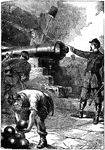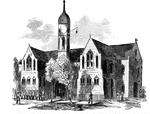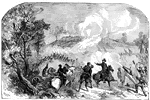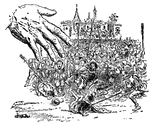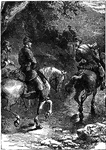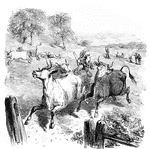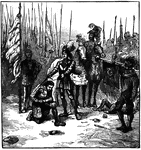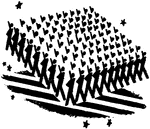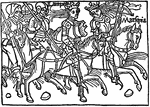
Frederick City
"General McClellan and the Federal troops passing through Frederick City, Md., in pursuit of the Confederate…

Freemont's troops
"Gathering of Fremont's troops on the prairie, near Tipton, Mo., on the eve of its departure in pursuit…
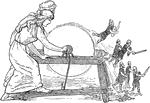
Frodi's Grindstone
In Norse mythology, Frey's son Frodi is given a magic grindstone from the fairies and elves. One who…

Battle of Gaines's Mill
"Battle of Gaines's Mill, Friday, June 27th, 1862. At eleven o'clock each division, brigade, regiment…
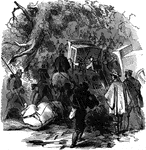
March of General Banks
"Incident in the march of General Banks's Division during a storm in Western Maryland." — Frank Leslie,…

Jesus Prays in the Garden of Gethsemane - Peter, James, and John Fall Asleep
"39 And he went forward a little, and fell on his face, and prayed, saying, My Father, if it be possible,…
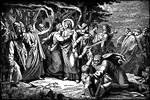
Judas Betrays Jesus and Peter Cuts Off the Ear of Malchus
"Again therefore he asked them, Whom seek ye? And they said, Jesus of Nazareth. Jesus answered, I told…

The Soldiers' Monument at Gettysburg
The monument erected to remember the soldiers who fought at the Battle of Gettysburg.

Giant Sitting on Wall
Gulliver sitting on a building in Lilliput with all the Lilliputians gathered around him.

View of Grafton
"View of Grafton, West Virginia, occupied by the Federal Troops, under the command of General McClellan,…

Grafton Occupied by Federal Troops
"View of Grafton, West Virginia, occupied by the Federal Troops, under the command of General McClellan,…

Railroad at Grafton
"View of Grafton, West Virginia, occupied by the Federal Troops, under the command of General McClellan,…
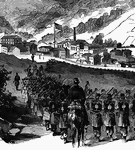
Federal Troops at Grafton, West Virginia
"View of Grafton, West Virginia, occupied by the Federal Troops, under the command of General McClellan,…

Battle of Grand Coteau
"The war in Louisiana- Battle of Grand Coteau- capture of the Sixty-seventh Indiana by the Texas Mounted…

Great Falls
"Shelling Confederate cavalry across the Potomac River from the heights of Great Falls, by Major West,…
Greek Soldiers in Arms
"From a Greek vase of about the time of the battle of Marathon."—Webster, 1913

Attack at Harrisonburg
"Gallant attack by 150 of the Pennsylvania Bucktails, led by Colonel Kane, upon a portion of General…
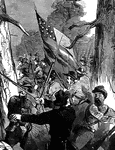
Attack at Harrisonburg
"Gallant attack by 150 of the Pennsylvania Bucktails, led by Colonel Kane, upon a portion of General…
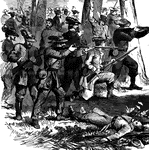
Attack at Harrisonburg
"Gallant attack by 150 of the Pennsylvania Bucktails, led by Colonel Kane, upon a portion of General…

Attack at Harrisonburg
"Gallant attack by 150 of the Pennsylvania Bucktails, led by Colonel Kane, upon a portion of General…
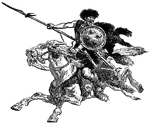
Hun Warrior on Horseback in Battle
Illustration of a Hun warrior riding on horseback, his mouth open as if to scream. The warrior has a…
!["[Caesar] mustered the soldiers in the Campius Martius, and requested a statement of their grievances. Their demands appeared to have a reference to a payment of their dues, the bestowal of promised presents, and a release from further duty. Caesar well knew that the best way to humiliate an insurrection is to grant what it clamors for. He accordingly made an address to his old legion, being careful to begin with "Citizens," instead of "Soldiers." This was gall and wormwood. To be addressed as citizens by their beloved commander! "I discharge you." said he. "You have had enough of fatigue and wounds. I release you from your oath. As to your presents, you shall be paid to the last sesterce." The old veterans could stand no more. They burst into tears, and began to beg for forgiveness. With a certain prudent hesitation, Caesar received them back to favor; but he took care that the leaders who had fomented the mutiny should be executed."—Ridpath, 1885](https://etc.usf.edu/clipart/78900/78945/78945_citizens_01_mth.gif)
Citizens! I Discharge You.
"[Caesar] mustered the soldiers in the Campius Martius, and requested a statement of their grievances.…
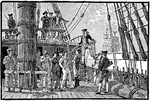
Impressment of American Sailors
The English Royal Navy would impress American sailors, kidnapping them to force them to serve in the…

Judas Sends Twelve Thousand Drachmas of Silver to Jerusalem
"And when he had made a gathering throughout the company to the sum of two thousand drachms of silver,…

Kentucky Raid
"The Confederate raid into Kentucky- the fight at the Licking Bridge, Cynthiana, between the Federal…

Kentucky Raid Rally
"The Confederate raid into Kentucky--excitement at Convington--gathering of armed Federal citizens at…
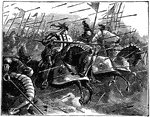
Knights Charging with Lances
An illustration of a group of knights charging on horseback with lances.
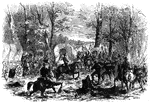
Lick Creek Bottom
"Advance of Federal troops on Corinth- the Carnival of Mud- scene at Lick Creek Bottom, between Pittsburg…
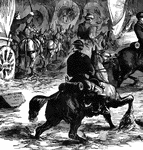
Lick Creek Bottom - Horse and Rider
"Advance of Federal troops on Corinth- the Carnival of Mud- scene at Lick Creek Bottom, between Pittsburg…
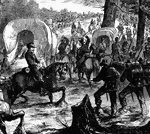
Lick Creek Bottom - In the Mud
"Advance of Federal troops on Corinth- the Carnival of Mud- scene at Lick Creek Bottom, between Pittsburg…

Lick Creek Bottom - Marching through the Mud
"Advance of Federal troops on Corinth- the Carnival of Mud- scene at Lick Creek Bottom, between Pittsburg…

Camp Lillie
Headquarters of General Freemont, Jefferson City, Missouri, October 1, 1861. Jefferson City is on the…
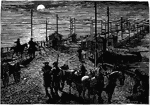
Soldiers Guarding Long Bridge
An illustration of soldiers guarding Long Bridge in Arlington, Virginia.

Military Personnel Marching to the Right
An illustration of military personnel marching straight with the right side of the image illustrating…
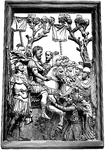
Marcus Aurelius and German Captives
"Marcus Aurelius receiving the submission of German captives. (From a Bas-relief in the Capitoline Museum,…

The Slaughter of the Innocents - Herod Has All of the Baby Boys Killed
"Then Herod, when he saw that he was mocked of the Wise-men, was exceeding wroth, and sent forth, and…

Arrival of General McClellan
April 5, 1862. The General is arriving to take personal command of the Federal Army in its advance on…
